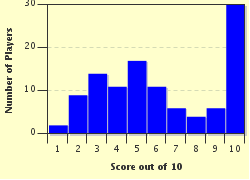Quiz Answer Key and Fun Facts
1. If I were a quokka, what type of creature would I be?
2. If I were a tenrec, what type of creature would I be?
3. If I were a bongo what type of animal would I be?
4. If I were a mata mata, what type of creature would I be?
5. If I were a vaquita, what type of creature would I be?
6. If I were a saola, what type of creature would I be?
7. If I was a kinkajou, what type of creature would I be?
8. If I were a civet what type of animal would I be?
9. If I were an Araripe manakin, what type of creature would I be?
10. If I were an hirola, what type of creature would I be?
Source: Author
wenray
This quiz was reviewed by FunTrivia editor
Tizzabelle before going online.
Any errors found in FunTrivia content are routinely corrected through our feedback system.


